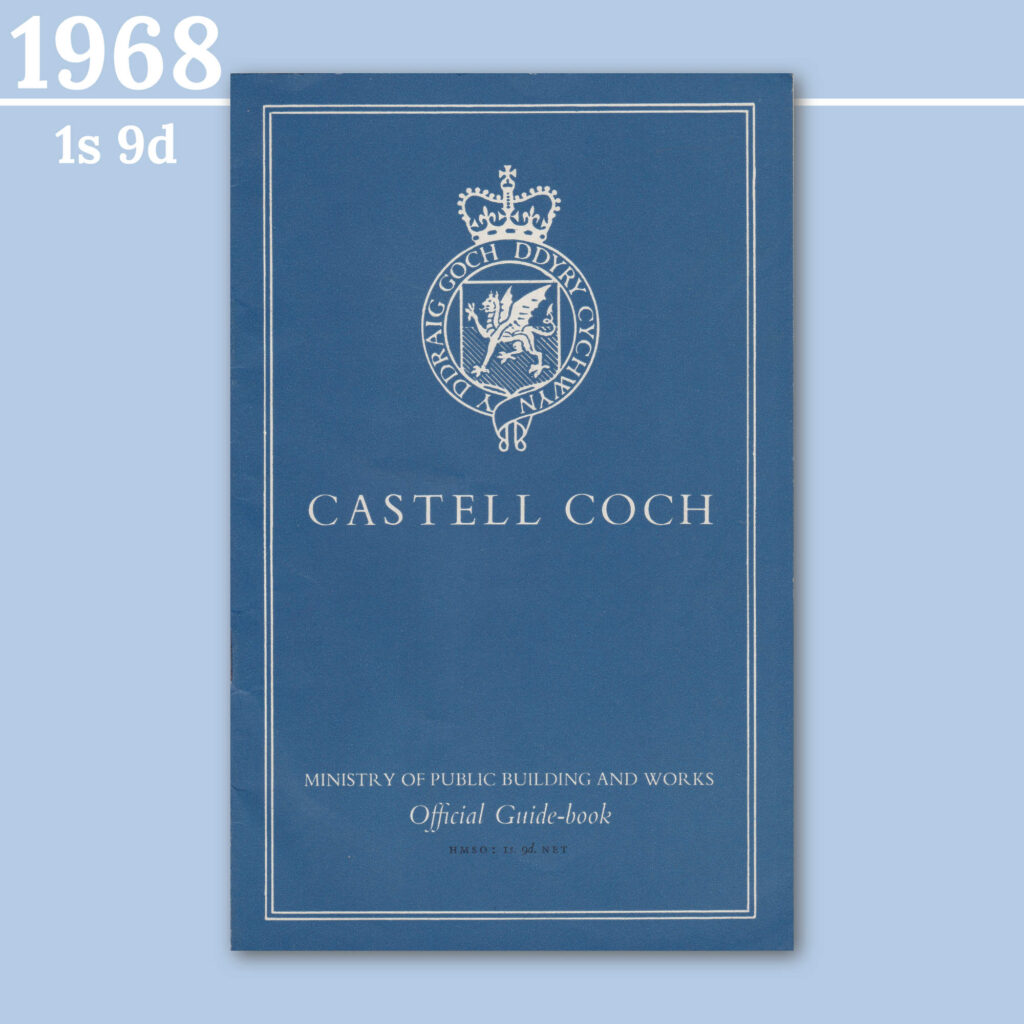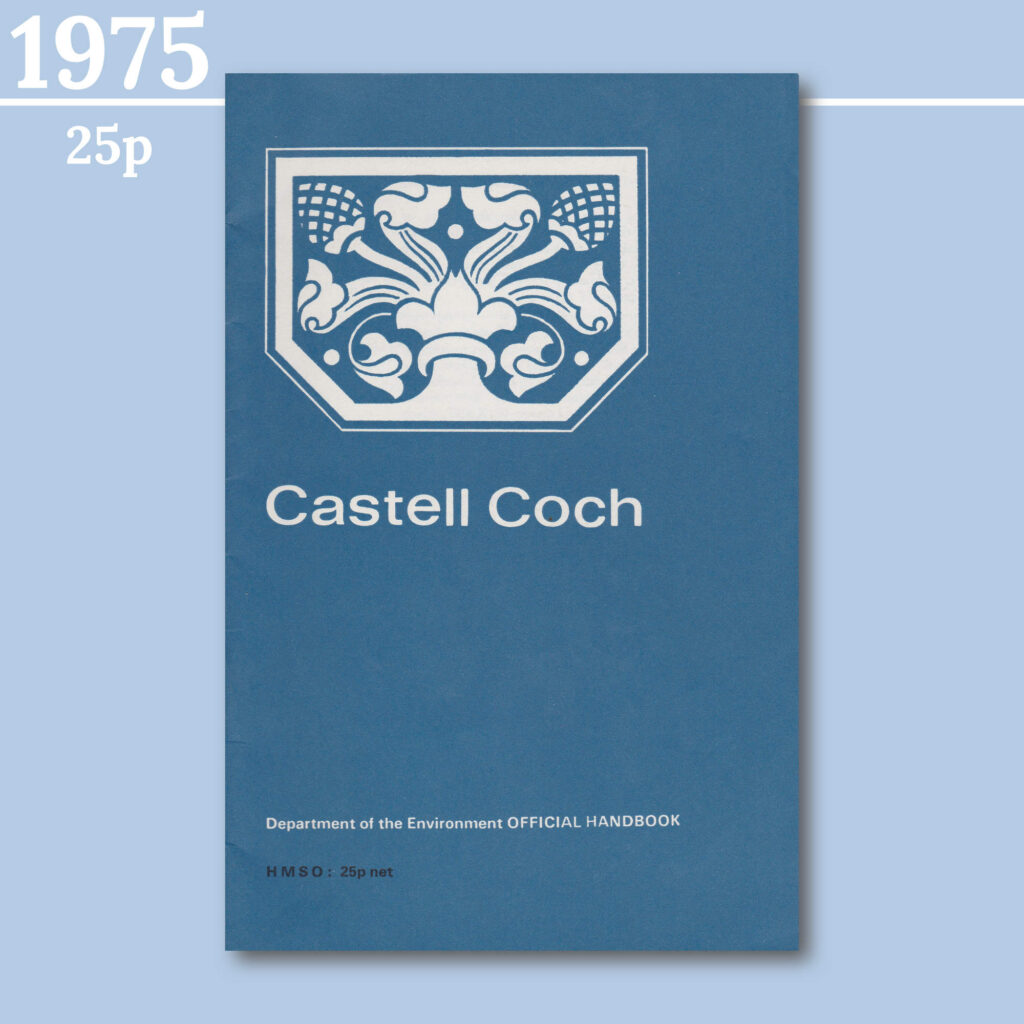Historic buildings in Wales have been managed by various organisations over the years. This collection of official guidebooks were published by some of these bodies from 1957 to 1975.
The original guide, published in 1954, was written by Peter Floud, C.B.E. (1911 – 1960), who was the Keeper of Circulation at the Victoria and Albert Museum.
The “Office of Works” was formed in 1851 and became the “Ministry of Works” in 1940. During this period, the Ancient Monuments Act (1882) and the Ancient Monuments Protection Act (1900) were introduced to protect monuments and encourage owners to place them in state guardianship.
1950s
Castell Coch was placed in the care of the Ministry of Works by the 5th Marquess of Bute in 1950.
This first example was published in 1957 and cost 1 shilling (12p). It’s often listed as a pamphlet because it only has 20 pages. I’ve always loved this early edition with its illustration of the castle. Unfortunately, there’s no information about the artist.

1960s
The “Ministry of Works” was renamed the “Ministry of Public Building and Works” in 1962.
Visiting the castle in 1957 cost 1 shilling (12p) for adults and 6d (6p) for children under 14. In 1962 the admission charge was the same but the children’s rate applied to under 15s. Annual season tickets cost 7s. 6d. (90p) for adults and 2s. 6d. (30p) for children.
On the cover of the 1962 reprint, and this eighth impression from 1968, is a new image and the familiar “blue book” design that was used for many sites. The illustration is a version of the 1953 augmented Royal Badge of Wales – the drawing of the dragon is significantly different and the crown/ribbon detail is very nicely simplified.

The motto, “Y Ddraig Goch Ddyry Cychwyn” translates to “The red dragon inspires action”. This badge was used on the unpopular 1953 Wales flag, which only lasted until 1959 when it was replaced by the current version.
This guidebook would cost visitors 1s 9d (21p).
1970s
The Ministry of Public Building and Works was absorbed into the Department of the Environment in 1970.
The 1975 edition uses a pattern from the banqueting hall fireplace on its cover and cost 25p. It’s the 11th reprint of the popular guidebook.

Each of these guidebooks contain very similar content. There’s a history of the castle and then descriptions of the exterior and each room. There’s a plan of the castle in the centre, images from Burges’ initial report and a couple of black and white photos.
The author opens with a criticism of the castle that’s still used to this day.
Castell Coch is in many ways a gigantic sham, a costly folly erected less than 100 years ago by an eccentric Victorian architect to satisfy the antiquarian yearnings of a wealthy nobleman.
Peter Floud – Castell coch official guidebook (1954)
He contrasts this by explaining why he thinks it’s worth preserving.
Yet it has been thought worthy to be taken over and preserved as a national monument – for two good reasons. It successfully reproduces the appearance of a type of thirteenth-century Welsh castle of which no authentic example survives intact, and its interior is a particularly striking example of Victorian imaginative decoration at its most original and exuberant.
PETER FLOUD – CASTELL COCH OFFICIAL GUIDEBOOK (1954)
I’ll go over the contents of the guidebook in a later article. I love how these books give a glimpse into how the castle was marketed in the mid to late 20th century.
The first guidebook produced under the management of Cadw was published in 1985. I’ll cover this in the next article in the series.



Interesting to see the way the representation of the Castle has changed over time. The 1954 message that the Castle is just a folly, without any mention of the pre-Bute history must have been communicated well as it was the story I was told as a child.
My mother would point to it every time we drove past (on our way from Swansea to London) and tell us it wasn’t worth visiting as it was only a folly. Little did I know (a) how spectacular it is or (b) its original much older history.
Little did I know I’d end up living somewhere where I can see it from the back of my garden!!